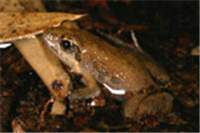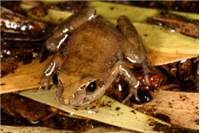Family
MyobatrachidaeGenus
Crinia
Species
parinsigniferaThreats/Control Methods - Regional
Broadscale threatening processes include; salinisation, habitat modification and urbanisation. Introduced species such as carp, trout, cats and foxes are known to hunt frogs or their tadpoles. Despite C. parinsignifera not currently being considered at risk, care should be taken at all times when entering frog habitats due to the risk of spreading disease, including the Chytrid fungus (chytridiomycosis). To prevent the spread of the Chytrid fungus it is important to wash your shoes before entering, AND after leaving frog habitats. For more information go to http://www.deh.gov/biodiversity/invasive/publications/c-disease/Local/Urban Actions
You can encourage frogs into your own backyard by including habitat features in your garden. The Ginninderra Catchment Group, Australian National University and Environment ACT have developed a guideline to help you encourage frogs into your backyard called Creating a Frog Friendly Habitat in the ACT Community.
You can also get involved in monitoring local frog populations. Frogwatch is an annual program run to monitor the presence and abundance of frogs within the ACT region. The Frogwatch program provides training for community volunteers each October, with monitoring then being undertaken by volunteers over a two week period.
For more information on Frogwatch contact:The ACT Frogwatch Coordinator, Ginninderra Catchment Group; Ph (02) 6278 3309 or email: [email protected]
Distinguishing Features
Adults average 2-3cm in length; the body is brown in colour, while the belly is grey; back patterns vary from ridges that run down the middle of the back, to bumps, to smooth. Tadpoles are small and brown with dark flecks all over. Eggs occur in loose clumps or singly.
Common name/s
Plains Froglet, Eastern Sign-Bearing Froglet, Beeping Froglet
Similar Species
C. parinsignifera looks very similar to C. signifera . The easiest way to tell them apart is by their mating calls. C. parinsignifera's call sounds like ©wwreeeek©, similar to the noise a wet finger makes when dragged over an inflated balloon. The call of C. signifera is a more rhythmic crick-crick-crick sound.
Distribution
Found in the southern regions of Queensland, throughout most of NSW through to the northern tip of Victoria and the south-eastern corner of South Australia.
Country of Origin
Australia
Survey Techniques
The most common technique for monitoring frog populations is based on call identification, with each frog species having a unique call. Frogs should not be handled without the use of sterile gloves, as their skin is very sensitive to chemicals, including soap and sunscreen. For more information see Local Actions below.
Conservation (Pet/Pest) Status - National
Not at risk
Conservation (Pet/Pest) Status - Regional
Not at risk
LSCCES Population
The increase in farm dams and urban wetlands has been beneficial to this species, and it is not considered under threat. C.parinsignifera was detected in 62% of the 2004 ACT Frogwatch sites.
Associated Vegetation Community
Commonly found in water covered woodlands, open plains and disturbed areas (such as farm dams and artificial wetlands).
Limiting Resources
Prefers still or slow moving water-bodies, living on their edges and banks. Unlike the closely related Crinia signifera this species does not occur above an altitude of 800m.
Breeding
Most breeding occurs in mid-winter. On average metamorphosis from tadpole to frog is completed in 11-12 weeks.
Behaviour
Calls from the waters edge commonly between August-November, but can be heard throughout the year.
Functional Group
Insectivorous
Food Species
Small invertebrates such as beetles (Coleoptera)
Predators
May include native birds, such as the White-Faced Heron (Egretta novaehollandiae) and Intermediate Egret, and fish, including the introduced Carp, Goldfish and Trout. Introduced species such as Cats (Felis catus) and Foxes may also predate on frogs.
Interesting Fact
Frogs drink and breathe through their skin and are very sensitive to chemicals in their environment. Where possible, you should not handle frogs, as the natural bacteria on your hands or chemicals such as sunscreen can damage their skin and cause illness or death.
References - (reader suitability of references, P=Primary teachers, S=Secondary students, T=Tertiary students and researchers)
Books:
Barker, J., Grigg,G., Tyler, M. (1995). A Field Guide to Australian Frogs. Surry Beatty & Sons. NSW, Australia. S, TLintermans,M. & Osborne, W. (2002). Wet & Wild: A Field Guide to the Freshwater Animals of the Southern Tablelands and High Country of the ACT and NSW. Environment ACT. Canberra, Australia. P, S, TRobinson, M. (1993). A Field Guide to Frogs of Australia. Australian Museum/Reed books. NSW, Australia. S, TTurner, J. (2004). Frogs of Australia. Pensoft. Bulgaria. S, TTyler, J. (1994). Australian Frogs: A Natural History. Reed New Holland. Australia. S, TSwan, G.(2001). Green Guide: Frogs of Australia. New Holland Publishers. Sydney, Australia. P, S
Online Publications:
Amphibian Research Centre. (2005). Crinia parinsignifera. Available Online: http://frogs.org.au/frogs/species/Crinia/parinsignifera/ S, TAustralian Frogs Database.(2005). Crinia parinsignifera. Available Online: http://frogsaustralia.net.au/frogs/display.cfm?frog_id=10 S, TDepartment of Environment and Heritage, (2004). Chytridiomycosis Factsheet http://www.deh.gov.au/biodiversity/invasive/publications/c-disease/ S, TEnvironment ACT.(2004). 5.Results;Crinia Parinsignifera. Available online: http://www.environment.act.gov.au/Files/frogwatchoctober2004-criniaparinsigniferaresults.pdfZoological Parks and Gardens Board. Frog Pond Checklist. Available Online: http://www.zoo.org.au/education/factsheets/amp-frog_pond_checklist.pdf P, S, TSpeare, R et al (1998). HOW TO REDUCE THE RISKS OF YOU TRANSMITTING AN INFECTIOUS AGENT BETWEEN FROGS AND BETWEEN SITES. Available Online: http://www.jcu.edu.au/school/phtm/PHTM/frogs/prevent.htm S, TZoological Parks Board N>S>W. (2005.). ASX Frog Focus. Available online: http://www.asxfrogfocus.com/ P, S (School activity program)
Researcher: Pippa Jaminon


 Top
Top Top
Top